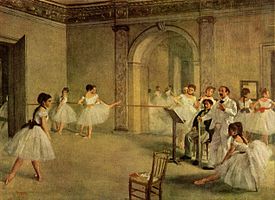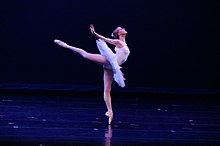Classical ballet

Classical ballet is a traditional, formal style of ballet that adheres to classical ballet technique. It is known for its aesthetics and rigorous technique (such as pointe work, turn-out of the legs, and high extensions), its graceful, flowing, and precise movements, and its ethereal qualities.
There are stylistic variations related to area of origin, which are denoted by classifications such as Russian ballet, French ballet, British ballet and Italian ballet. For example, Russian ballet features high extensions and dynamic turns, whereas Italian ballet tends to be more grounded, with a focus on fast, intricate footwork. Many of the stylistic variations are associated with specific training methods that have been named after their originators. Despite the variations, the performance and movement vocabulary of classical ballet are largely consistent throughout the world.
History
Ballet originated in the Italian Renaissance courts and was brought to France by Catherine de' Medici in the 16th Century.[1] During ballet's infancy, court ballets were performed by aristocratic amateurs rather than professional dancers.[1] Most of ballet's early movements evolved from social court dances and prominently featured stage patterns rather than formal ballet technique.
In the 17th century, as ballet's popularity in France increased, ballet began to gradually transform into a professional art. No longer performed by amateurs, ballet performances started to incorporate challenging acrobatic movements that could only be performed by highly skilled street entertainers.[1] In response, the world's first ballet school, the Academie de Dance, was established by King Louis XIV in 1661.[1] The Academie's purpose was to improve the quality of dance training in France, and to invent a technique or curriculum that could be used to transform ballet into a formal discipline. Shortly after the Academie was formed, in 1672, King Louis XIV established a performing company called the Academie Royal de Musique de Dance (today known as Paris Opera), and named Pierre Beauchamp the head dancing-master.[1] While at the Academie Royal, Beauchamp revolutionized ballet technique by inventing the five positions of ballet, which to this day remain the foundation of all formal classical ballet technique.[1]
Technique

Ballet technique is the foundational principles of body movement and form used in ballet. A distinctive feature of ballet technique is the continuous outward rotation of the thighs from the hip, referred to as "turnout". There are five foundational leg positions in classical ballet, all performed with turnout. The first, second, third, fourth and fifth positions. Sixth and seventh positions were utilised by Serge Lifar, but are rarely recognised within any training method. When performing jumps and leaps, classical ballet dancers strive to exhibit ballon, the appearance of briefly floating in the air.
Training

Students typically learn ballet terminology and the pronunciation, meaning, and precise body form and movement associated with each term. Emphasis is placed on strengthening the legs and body core (the center, or abdominals) as a strong core is required for many ballet movements (especially turns), and on developing flexibility and strengthening legs and feet.
After learning basic ballet technique and developing sufficient strength and flexibility, female dancers begin to learn pointe technique and male and female dancers begin to learn partnering and more advanced jumps and turns. Depending on the teacher and training system, students may progress through various stages or levels of training as their skills advance.
Ballet class attire
Female attire typically includes pink, black, or flesh colored tights, a leotard, and sometimes a short wrap-skirt. Males typically wear black or dark tights, a form-fitting white shirt or leotard worn under the tights, and a dance belt beneath the outer dancewear to provide support. In some cases, students may wear a unitard — a one-piece garment that combines tights and a leotard — to enhance the visibility of artistic lines.
All dancers wear soft ballet shoes (sometimes called flats). Typically, female dancers wear pink or beige shoes and men wear black or white shoes. Leg warmers are sometimes worn during the early part of a class to protect leg muscles until they become warm. Females are usually required to restrain their hair in a bun or some other hair style that exposes the neck. The customary attire and hair style are intended to promote freedom of movement and to reveal body form so that the teacher can evaluate dancers' alignment and technique. After warming up, advanced female students may wear pointe shoes whereas advanced male students continue to wear soft shoes. Pointe shoes are worn after the student is deemed strong enough in the ankles and can execute the routine to a high standard.
Methods
There are several standardized, widespread, classical ballet training systems, each designed to produce a unique aesthetic quality from its students. Some systems are named after their creators; these are typically called methods or schools. For example, two prevailing systems from Russia are the Vaganova method (created by Agrippina Vaganova) and the Legat Method (by Nikolai Legat). The Cecchetti method is named after Italian dancer Enrico Cecchetti. Another training system was developed by and named after August Bournonville; this is taught primarily in Denmark. The Royal Academy of Dance (RAD) method was not created by an individual, but by a group of notable ballet professionals. Despite their associations with geographically named ballet styles, many of these training methods are used worldwide. For example, the RAD teaching method is used in more than 70 countries.
American-style ballet (Balanchine) is not taught by means of a standardized, widespread training system. Similarly, French ballet has no standard training system; each of the major French-style ballet schools, such as the Paris Opera Ballet School, Conservatoire National Supérieur de Musique et de Danse, and Académie de Danse Classique Princesse Grace (Monaco) employs a unique training system.
| Ballet style | Training system | |
|---|---|---|
| Name | Creator | |
| Danish ballet | Bournonville method | August Bournonville |
| Italian ballet | Cecchetti method | Enrico Cecchetti |
| Russian ballet | Vaganova method | Agrippina Vaganova |
| Legat Method | Nikolai Legat | |
| English ballet | Royal Academy of Dance | Various |
| Cecchetti method[disputed – discuss] | Enrico Cecchetti | |
| French ballet | None | |
| American ballet (Balanchine) | None | |
See also
References
External links
Sources
- Anderson, Jack (1992). Ballet & Modern Dance: A Concise History (2nd ed. ed.). Princeton, NJ: Princeton Book Company, Publishers. ISBN 0-87127-172-9.
{{cite book}}:|edition=has extra text (help) - Bland, Alexander (1976). A History of Ballet and Dance in the Western World. New York: Praeger Publishers. ISBN 0-275-53740-4.
- Chantrell, Glynnis, ed. (2002). The Oxford Essential Dictionary of Word Histories. New York: Berkley Books. ISBN 0-425-19098-6.
- Kirstein, Lincoln (1952). The Classic Ballet. New York: Alfred A Knopf.
{{cite book}}: Unknown parameter|coauthors=ignored (|author=suggested) (help) - Lee, Carol (2002). Ballet In Western Culture: A History of its Origins and Evolution. New York: Routledge. ISBN 0-415-94256-X.
